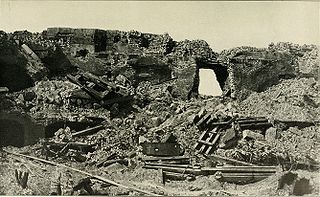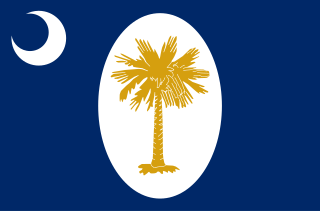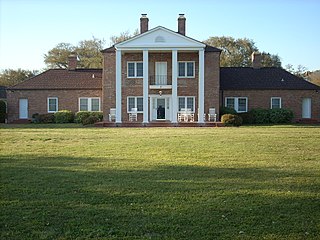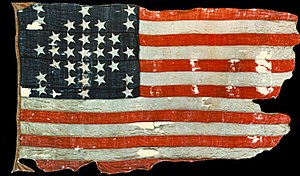
The national flag of the United States, often referred to as the American flag or the U.S. flag, consists of thirteen horizontal stripes, alternating red and white, with a blue rectangle in the canton bearing fifty small, white, five-pointed stars arranged in nine offset horizontal rows, where rows of six stars alternate with rows of five stars. The 50 stars on the flag represent the 50 U.S. states, and the 13 stripes represent the thirteen British colonies that won independence from Great Britain in the American Revolutionary War.

Fort Sumter is a sea fort built on an artificial island near Charleston, South Carolina to defend the region from a naval invasion. It was built after British forces captured and occupied Washington during the War of 1812 via a naval attack. The fort was still incomplete in 1861 when the Battle of Fort Sumter occurred from April 12 to 13, sparking the American Civil War. It was severely damaged during the battle and left in ruins. Although there were some efforts at reconstruction after the war, the fort as conceived was never completed. Since the middle of the 20th century, Fort Sumter has been open to the public as part of the Fort Sumter and Fort Moultrie National Historical Park, operated by the National Park Service.

Fort McHenry is a historical American coastal pentagonal bastion fort on Locust Point, now a neighborhood of Baltimore, Maryland. It is best known for its role in the War of 1812, when it successfully defended Baltimore Harbor from an attack by the British navy from Chesapeake Bay on September 13–14, 1814.

The Battle of Fort Sumter was the bombardment of Fort Sumter near Charleston, South Carolina, by the South Carolina militia. It ended with the surrender of the fort by the United States Army, beginning the American Civil War.

The Battle of Fort Henry was fought on February 6, 1862, in Stewart County, Tennessee, during the American Civil War. It was the first important victory for the Union and Brig. Gen. Ulysses S. Grant in the Western Theater.

Robert Anderson was a United States Army officer during the American Civil War. He was the Union commander in the first battle of the American Civil War at Fort Sumter in April 1861 when the Confederates bombarded the fort and forced its surrender, starting the war. Anderson was celebrated as a hero in the North and promoted to brigadier general and given command of Union forces in Kentucky. He was removed late in 1861 and reassigned to Rhode Island, before retiring from military service in 1863. In 1865, he returned to Fort Sumter to again raise the American flag that he had lowered during the 1861 surrender.

The flag of South Carolina is a symbol of the U.S. state of South Carolina consisting of a blue field with a white palmetto tree and white crescent. Roots of this design have existed in some form since 1775, being based on one of the first American Revolutionary War flags. While keeping most of its design intact since its adoption, it has varied over the years.
The following is a list of engagements that took place in 1861 during the American Civil War.

Fort Moultrie is a series of fortifications on Sullivan's Island, South Carolina, built to protect the city of Charleston, South Carolina. The first fort, formerly named Fort Sullivan, built of palmetto logs, inspired the flag and nickname of South Carolina, as "The Palmetto State". The fort was renamed for the U.S. patriot commander in the Battle of Sullivan's Island, General William Moultrie. During British occupation, in 1780–1782, the fort was known as Fort Arbuthnot.

Francis Wilkinson Pickens was a politician who served as governor of South Carolina when that state became the first to secede from the United States. A cousin of Senator John C. Calhoun, he was born into the Southern planter class. A member of the Democratic Party, Pickens became an ardent supporter of nullification of federal tariffs when he served in the South Carolina House of Representatives before he was elected to the United States House of Representatives.

The siege of Fort Pulaski concluded with the battle of Fort Pulaski fought April 10–11, 1862, during the American Civil War. Union forces on Tybee Island and naval operations conducted a 112-day siege, then captured the Confederate-held Fort Pulaski after a 30-hour bombardment. The siege and battle are important for innovative use of rifled guns which made existing coastal defenses obsolete. The Union initiated large-scale amphibious operations under fire.

The Second Battle of Fort Sumter was fought on September 8, 1863, in Charleston Harbor. Confederate General P. G. T. Beauregard, who had commanded the defenses of Charleston and captured Fort Sumter in the first battle of the war, was in overall command of the defenders. In the battle, Union forces under Major General Quincy Gillmore attempted to retake the fort at the mouth of the harbor. Union gunners pummeled the fort from their batteries on Morris Island. After a severe bombing of the fort, Beauregard, suspecting an attack, replaced the artillerymen and all but one of the fort's guns with 320 infantrymen, who repulsed the naval landing party. Gillmore had reduced Fort Sumter to a pile of rubble, but the Confederate flag still waved over the ruins.

South Carolina was the first state to secede from the Union in December 1860, and was one of the founding member states of the Confederacy in February 1861. The bombardment of the beleaguered U.S. garrison at Fort Sumter in Charleston Harbor on April 12, 1861, is generally recognized as the first military engagement of the war. The retaking of Charleston in February 1865, and raising the flag again at Fort Sumter, was used for the Union symbol of victory.

Charleston, South Carolina, was a hotbed of secession at the start of the American Civil War and an important Atlantic Ocean port city for the fledgling Confederate States of America. The first shots against the Federal government were those fired there by cadets of the Citadel to stop a ship from resupplying the Federally held Fort Sumter. Three months later, the bombardment of Fort Sumter triggered a massive call for Federal troops to put down the rebellion. Although the city and its surrounding fortifications were repeatedly targeted by the Union Army and Navy, Charleston did not fall to Federal forces until the last months of the war. Charleston was devastated.

The Star-Spangled Banner, or the Great Garrison Flag, was the garrison flag that flew over Fort McHenry in Baltimore Harbor during the naval portion of the Battle of Baltimore during the War of 1812. It is on exhibit at the National Museum of American History, Smithsonian Institution. Seeing the flag flying over Fort McHenry on the morning of September 14, 1814, after the battle ended, Francis Scott Key was inspired to write the poem "Defence of Fort M'Henry". These words were written by Key and set to the tune of "To Anacreon in Heaven", a popular song at the time, by John Stafford Smith. In 1931 the song became the national anthem of the United States.

The Second Battle of Charleston Harbor, also known as the Siege of Charleston Harbor, the Siege of Fort Wagner, or the Battle of Morris Island, took place during the American Civil War in the late summer of 1863 between a combined U.S. Army/Navy force and the Confederate defenses of Charleston, South Carolina.

Siege artillery is heavy artillery primarily used in military attacks on fortified positions. At the time of the American Civil War, the U.S. Army classified its artillery into three types, depending on the gun's weight and intended use. Field artillery were light pieces that often traveled with the armies. Siege and garrison artillery were heavy pieces that could be used either in attacking or defending fortified places. Seacoast artillery were the heaviest pieces and were intended to be used in permanent fortifications along the seaboard. They were primarily designed to fire on attacking warships. The distinctions are somewhat arbitrary, as field, siege and garrison, and seacoast artillery were all used in various attacks and defenses of fortifications. This article will focus on the use of heavy artillery in the attack of fortified places during the American Civil War.

The Floating Battery of Charleston Harbor was an ironclad vessel that was constructed by the Confederacy in early 1861, a few months before the American Civil War ignited. Apart from being a marvel to contemporary Charlestonians, it was a strategic naval artillery platform that took part in the bombardment of Fort Sumter on April 12 and April 13, 1861, making it the first floating battery to engage in hostilities during the Civil War.

Fort Johnston was a British fort, later a United States Army post, in Brunswick County, North Carolina on Moore Street near Southport, North Carolina. It stands on the west bank of the Cape Fear River, four miles above its mouth.
The American Civil War did not have a clear ending, but by the beginning of April 1865 it was obvious that the Union had won. Richmond fell on April 2. The Army of Northern Virginia surrendered to General Ulysses Grant at Appomatox Court House on April 9, 1865. This good news produced, in the North, a call for public celebrations.



















